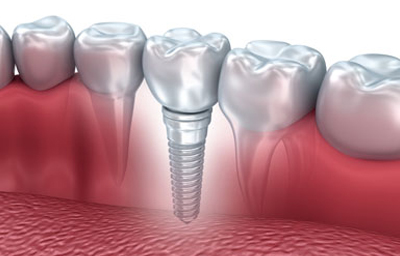Why Choose a Dental Implants

The loss of teeth due to disease or trauma creates a problem that affects many individuals. The first step in evaluating dental restorative options is to consult with one's dentist. This appointment will include an evaluation of the individual's health history, a comprehensive oral evaluation of hard and soft tissues, and any necessary x-rays. If a dental implant is an option, a 3-D cone beam computed tomography (CBCT) scan will be required to fully evaluate the proposed surgical site.
For single tooth loss, the advantage of using a dental implant is that the adjacent teeth do not need to be disturbed during the restorative process. As opposed to placement of a dental bridge, where the adjacent teeth are prepared and crowned to support the false tooth or pontic, a dental implant requires only the area where the tooth is missing to be restored. In addition, a dental implant decreases bone loss and stabilizes the area for a healthier jaw. The fusion of the implant to the jawbone helps to conserve bone volume, thus allowing surrounding tissues to be preserved.
If a tooth is extracted and a dental implant is going to be placed, the dentist will first graft bone into the extraction site to preserve the implant location. The patient will need to wait approximately four months for the bone to integrate into the area before the implant can be placed. An additional four months must pass for the implant to fuse to the surrounding bone. Once the waiting periods have been met, the final restoration can begin. An abutment, the prosthetic metal part that joins the implant to the crown, is placed and a crown positioned on top of the abutment.
Implants can also be used to replace multiple teeth or to anchor a denture. Multiple implants can be placed at one time so that the entire mouth can be restored. Placement of implants is easier in the lower jaw due to the amount of bone that is present in the mandible. In the maxilla or upper jaw, the process of placing implants is more complicated due to insufficient bone quality and the presence of the sinus. If the sinus hangs too low, additional procedures may be necessary to correct the issue so that the implant can be placed.
Maintenance of implants is the same as one's natural teeth. Good oral hygiene, including brushing and flossing, is necessary to keep the implant clean. When cleanings are performed at one's dentist's office, special instruments are required to clean around the implant. Also, the dentist will check at the exam that the abutment and implant are secure.
With the variety of options available to keep one's teeth, an individual truly can have teeth for their lifetime and achieve the smile one desires. Working with the dentist to examine all options is the best option to accomplish one's personal goals.

